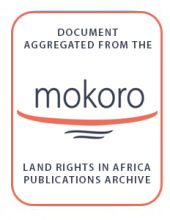Land Library
Welcome to the Land Portal Library. Explore our vast collection of open-access resources (over 74,000) including reports, journal articles, research papers, peer-reviewed publications, legal documents, videos and much more.
/ library resources
Showing items 1 through 9 of 20.Zimbabwe today has an agrarian structure made up of small, medium and large farms, all under different forms of land ownership.
A Kenyan air pilot involved in a project testing the use of drones for land mapping and registration in Kenya, Rwanda and Ethiopia. If successful, hopes it will be rolled out elsewhere on the continent. Still awaiting permission to fly the drones. Kenya has developed guidelines on drones.
A land audit responding to the facts that policy formulation around the very sensitive and complex issue of land has been based on perception rather than fact for too long and that no reliable figures on land ownership in South Africa exist.
In Cambodia, the majority of the population is still composed of smallholder family farmers. 54% of the total labour force is employed in agriculture. They have access to 3.6 million ha of land, representing 19% of the country’s total land.
The process to develop a new Land Code in Chad is a positive step forward but the draft reflects a highly centralised system of land ownership, management and administration which risks excluding most people from the means to document and protect their land rights while also fostering widespread
The Guiding Principles are designed to help a number of stakeholders develop larger-scale agricultural investments that are more likely to prove sustainable, beneficial, and successful for communities, investors and governments.
In Liberia it is estimated that around half the country’s land mass has been promised to foreign companies and investors.
Paper discusses Zambia’s dual land tenure system, the ways in which gender issues have been incorporated in legal and policy documents, and the extent to which this has been reflected in practice.
Land Rush is a one hour documentary film shot in Mali exploring the huge expansion of international agribusiness on Africa’s most fertile arable land. In Mali, 75% of the country’s population are farmers but only 5% of the land is arable.


